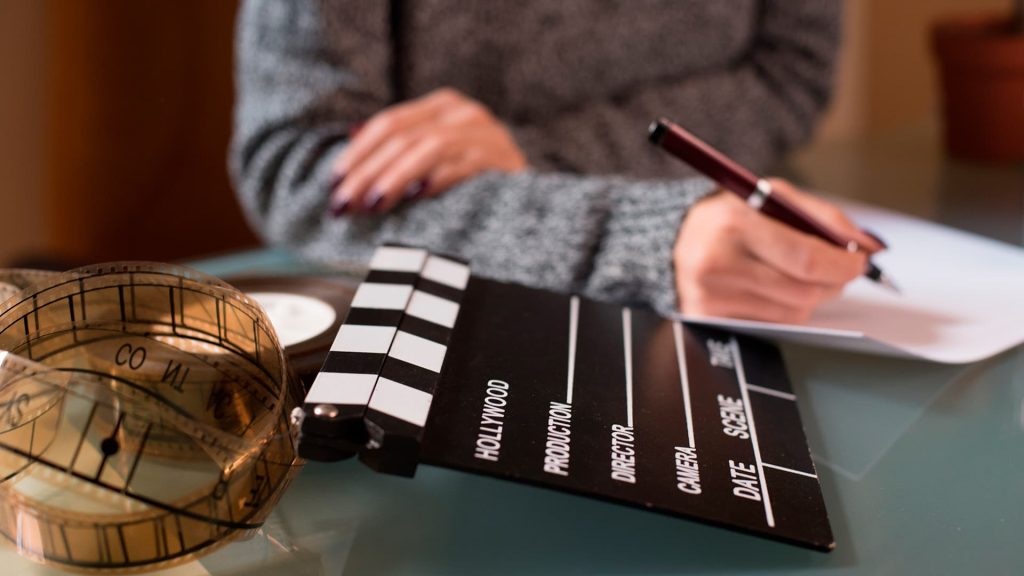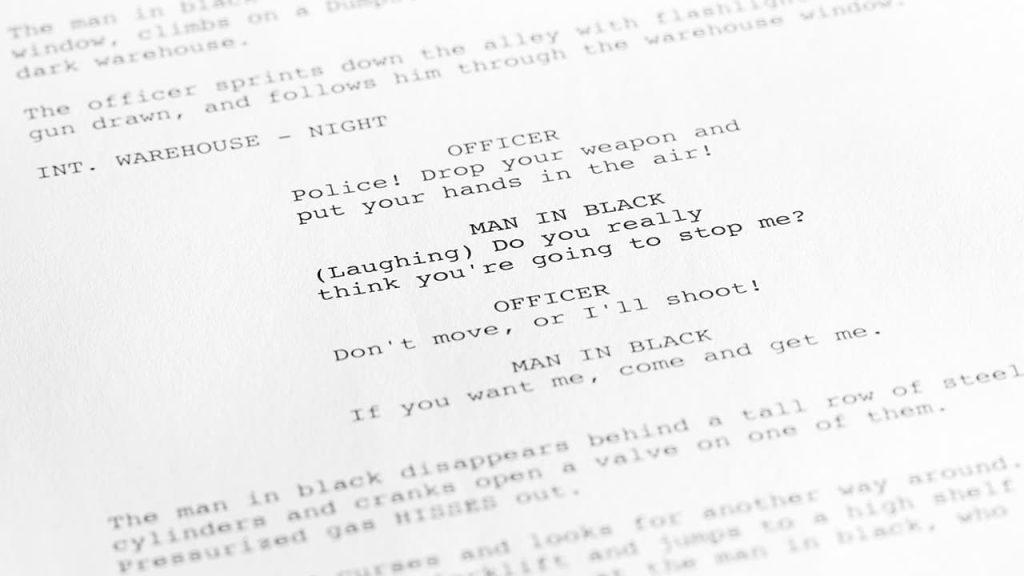
How to write a movie script
How would you feel about seeing your story on the big screen? If you are a copywriter and want to get started as a screenwriter to write movies, short films or series, read this article carefully. In it we tell you how to write a movie script step by step.
As you know, being a writer is a very creative job that allows you to let your imagination run wild, and that also means facing possible blocks. So before we dive right into this topic, we want to recommend you an article to read next: how to become a successful writer (+ 5 tips).
Our goal today is to share with you this mini-guide to teach you how to write a movie script. There are no magic recipes, nor infallible processes, because it is a creative work. But by following the steps we are going to recommend below, you will work in an organized and clear way, without unexpected surprises. So let’s get to it!
What is a literary script?
First of all, you should know that the script is the text in which all the details necessary to make audiovisual content (films, programs, series, etc.) are set out. It is a working tool that is shared with all the teams involved in a project (direction, production, art directors, directors of photography, etc.). Everyone must understand it perfectly, so it must be attractive and easy to read.
There are different types of scripts:
- Literary script: explains the film (what happens and who it happens to).
- Technical script: details the shots and camera movements.
- Illustrated script: refers to the storyboard. In this case, the literary script is combined with the technical script to illustrate the film’s story.
Here are the 8 steps to write a movie script.
Step 1. The idea
Writing a movie script starts with the idea. And it has to be clear, with a main character, a goal, a conflict, and a beginning and an end. You already know that it is very likely that the script will undergo modifications during the creation process, even once it is being shot. So you may ask yourself, do I have to write a closed ending? The best thing to do is to do it. Think that having a beginning and an end will help you write the outcome. And, more importantly, it will make sense.
Another essential point, in addition to the idea being clear and simple, is that it must be viable. The feasibility of a project is usually linked to the budget, so you will have to think about the resources needed to make the film.

If it is one of your first scripts, it is better if it is an idea that does not require a very high investment (we are talking about millions of dollars). It is true that nowadays thanks to technology you can recreate almost any scenario, but it takes a good part of the budget, which makes you lose interest in the script. So before betting on a specific idea it is important to reflect on this issue.
Step 2. The logline
The logline is a sentence that summarizes the script (the protagonist and its objective). It is written in the third person and should occupy a line or two approximately. It may not seem like a lot of space, but remember that it is not a synopsis, so you can do it by writing a few words.
Answering these 3 questions may help you with it:
Who is the main character?
What does he/she want to achieve?
What or who stands in his/her way?
If in addition to answering these 3 questions you can include some additional information about the tone of the story, the place or the time, you would have a logline of 10.
Step 3. The Plot
The plot is the extension of the idea. Here we already tell the whole story, with the beginning, the middle and the end. Normally, your script will have more than one protagonist or secondary character, so you can choose to:
- Write a single line of action: the protagonist and his or her objective.
- Write plots and subplots: the protagonist and his objective and parallel lines of action.
As for the length, as a guideline, the plot can be written in one page, always taking into account the type of content we are working on. For example, short films can be written in less space.
Step 4. The characters
This is a very important point. The construction of the characters is fundamental so that there is nothing in the story that “squeaks”. And it can become a somewhat complex process.
To make it easier, it is advisable to write character profiles for all the characters, not just the main characters. If you are working on your first scripts, you should write an index card for each character. In them you will describe all the necessary traits, both physical and psychological. The more details they have, the better.
In the construction of each character there are 2 fundamental points that you must take into account:
- Pre-history. Each character has a past that makes him/her the way he/she is. To define him, you can think about his childhood, what family he had, his friendships, studies, work life, etc. All this will build his character and personality.
- Characterization. What the character is like in the present: age, physical appearance, style and way of dressing, habits, tastes, fears, hobbies, etc. Small details make it believable. Viewers like to see on screen people with their own tastes, concerns or tics… because they make it more “real”.
For example, if a character is lazy, it would be strange to have an athletic physical appearance, it would not be realistic and the viewer would not believe it. Defining all these details beforehand makes the story you will write later connect better with the audience.
The purpose of creating the cards is so that you can clearly visualize each character and know how he or she would behave in each situation. You can describe as many aspects as you want. The ones you should not forget are: the character’s objective, goal and fears. If you have these points clear, the interaction will be more natural and the dialogues will be more fluid.
Step 5. The outline
The story outline allows us to decide how we tell the story. This document will serve to develop the plot, scene by scene, and order all the parts. You can imagine it as a table of contents that describes each of the scenes in the script.
There are 3 types of outlines:
- Basic outline: the main plot is written.
- Intermediate outline: the subplots between the characters are included.
- Integral outline: combines the basic and the intermediate one to write the film’s play-list.
The key to any good outline is that the text should be schematic. As writing recommendations, use few words and simple sentences. Remember that no dialogue is included here. Finally, you should write it in third person and present tense.
Step 6. The treatment
The treatment is a document that develops the outline a little more, but it is not the literary script. For this reason, it is sometimes overlooked, but it is very important to work on it. In it you will explain the story, scene by scene, but without giving the details of the dialogue or describing the characters. We will leave this for the literary script. Since the treatment usually generates confusion, let’s see a clear example:
In the basic outline we would write a scene like this:
“Pablo enters. Conversation with Elena”.
While in the treatment it would be something like this:
“Pablo enters Elena’s room and they have a long and heated conversation about the future of their relationship”.
The length of this document varies depending on the project. As a guideline, they are usually between 25 and 60 pages for a film project, and about 10 pages for a short film.
Step 7. The literary script
Here we come to the long-awaited (and also the longest) phase: the writing of the literary script. The truth is that there are a number of unwritten rules for writing this document, so take note!

7. 1) The ideal is to describe actions in a simple way following the structure of subject + verb + predicate, in the present tense.
7. 2) Keep in mind that one page is more or less equivalent to one minute of footage, so a 1.5 hour movie will have a literary script of approximately 90 pages.
7. 3) It is written using Courier New font, size 12, single-spaced and lowercase. Capital letters are reserved exclusively for:
- The heading of the scene.
- The name of the character speaking.
- The name the first time a character appears.
- The final transition of the scene.
7. 4) The margins must be the correct size. There are specialized programs for writing literary scripts that take these specifications into account. But if you want to work with text editors such as Word or Pages, remember to set the following values:
- Left margin: 3 cm
- Right margin: 2 cm.
- Margin top: 3 cm.
- Bottom margin: 2 cm.
- Page number: located on the right.
If you have already adjusted these settings, you are ready to write! Let’s start.
Each scene consists of 4 parts:
The header
Where and when the scene takes place.
- Mention whether it is interior (INT) or exterior (EXT).
- The location is described concretely.
- It is defined if it is day or night.
The description of the setting (if necessary)
It is written in a general way, without going into details. For example, a new black car.
Actions
Describes everything that happens in the scene. Here you would mention everything that is not said in the dialogues.
Dialogues
This is the most important part of the literary script.
- They are the lines that the actors will utter during the shooting.
- You only have to write the text, not how the actor would have to say it.
- It should not include parentheses, notes, transitions or shots.
Step 8: Registration of your work
Some people think that the process ends at the previous point, but now comes the most important step: registering your work. And this does not only refer to the literary script. We are talking about a long work process, so you can register the different documents you are writing (plot, outline, treatment…) until, finally, registering the whole work.

Making a film script can take you months, so we recommend you to protect your work, proving the authorship of the work in any situation. If you think about it, showing a literary script or any other document without registration is compromising all the creative work done. Besides, in order to sell it, you will have to present it to interested parties, so the most professional thing to do is to have a proof with a registration date.
Remember that by the mere fact of writing the work you are entitled to the copyright. However, registration goes one step further and gives the creator a guarantee and proof of authorship. You can register a literary work online at Safe Creative.
